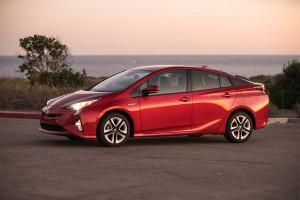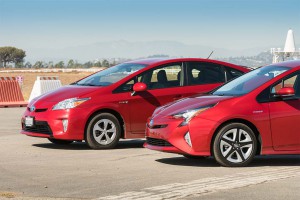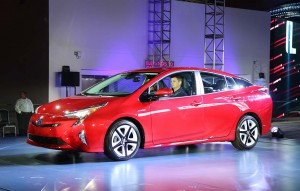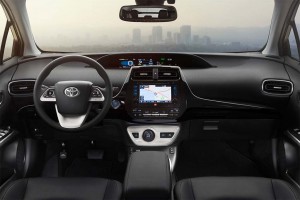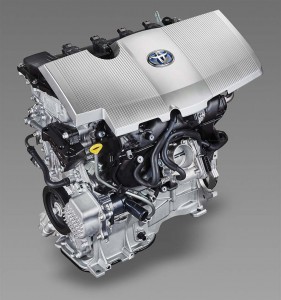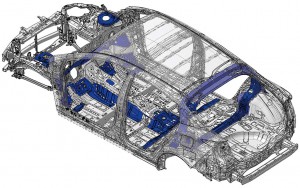In an era when so many cars have a tendency to look alike, the Toyota Prius has been an unabashed, if somewhat geeky, standout. Of course, it’s what’s below the skin that really makes the difference. The Prius was the world’s first hybrid-electric vehicle when it made its debut in Japan in 1997 and, ever since, it has overwhelmingly dominated that segment worldwide.
But times have changed, and the third-generation Toyota Prius has been losing a lot of sales momentum this year. There are several reasons why, perhaps most notably the sharp slide in fuel prices that has reduced demand for all “green” vehicles. But there are other factors, among other things that geeky design and the less than thrilling ride offered by the old Prius.
And those are issues Toyota has set out to address with the fourth-generation hybrid. The 2016 Toyota Prius gets a complete, top-to-bottom makeover: new skin, a new platform, a new independent rear suspension — and an updated Hybrid Synergy Drive system that delivers as much as 10% better mileage.
Once again, the Prius can lay claim to being the most fuel-efficient car on U.S. roads that doesn’t need to be plugged in. But might it also live up to Toyota’s claims, Bill Fay, the head of the brand declaring, “it’s not just about miles per gallon anymore”? Might it actually now be fun to drive? That’s something we wanted to find out as we set off for San Jose, California, and our first chance to drive the gen-four hybrid.
We’d already gotten a first look at the 2016 Toyota Prius during a flashy – if not entirely enlightening – preview in Las Vegas several months earlier. Visually, the Prius goes a little more mainstream, especially from a side profile, where it looks much like so many other compact hatchbacks, the roof moving forward about six inches.
The nose still picks up a bit of the beak introduced on the previous Prius, but the face is, overall, more in line with the rest of the Toyota family, with a small upper grille framed by boomerang LED headlamps, and a yawning lower grille, itself bordered by new, silvered foglamps. There are new creases in the hood which, on more conventional vehicles might be dubbed “power bulges.”
A pronounced crease flares out of the back doors, rising beneath the new, black-out C-pillar, to become part of the integrated rear spoiler. As before, there’s a crossbar that provides some strength to the hatchback glass – but which also disrupts rear visibility. The taillights take on an almost fin-like quality, meanwhile.
Beyond the rejiggered roofline, the new 2016 Toyota Prius has been stretched about 2.4 inches in length. It’s about 0.6 inches wider but also sits an inch lower. Meanwhile, Toyota says the new hybrid’s center of gravity has been lowered an inch, as well. Oddly, passenger space has actually shrunk by three cubic feet, to 22 cf, though there’s slightly more cargo space.
Inside, Toyota has tried to address some of the most frequent criticism focusing on the cheap, plastic feel of the old Prius cabin. There are more soft-touch materials, and a nicer finish to the new center stack. There’s a new full-color TFT display on top of the dashboard that does a better job of highlighting key information. But critics are still likely to be bothered by having to look to the right to see the speedometer.
Toyota has still succumbed to a weakness we’ve seen on so many recent Japanese models – a lack of buttons and knobs , with audio volume still operated by a virtual control alongside the central information and navigation screen.
One of the most controversial elements of the 2016 Toyota Prius redesign is found immediately below that cluster, however. The car’s shifter has been slightly relocated and now impales a chunk of white plastic trim that might look nice on an iPhone but just doesn’t fit in a car. The same material extends to the center console, making it all the more intrusive. Oddly, Chevrolet drew sharp criticism for using the same plastic on its first-generation Volt, wisely abandoning it for the 2016, second-gen model.
One key reason for the exterior dimensional changes with the new Prius is the move away from a dedicated chassis to the Toyota New Generation Architecture, or TNGA. That platform will be used for a significant number of the Japanese maker’s future product line-up. Toyota claims that will help it improve manufacturability and lower production costs. But it also means a stiffer body that should be more crashworthy while also improving driveability.
(Toyota wants to eliminate gas powered cars. Click Here to see how soon.)
To further improve ride and handling, the 2016 Toyota Prius gets a double-wishbone rear suspension, an overdue replacement for the live axle found in the first three iterations of the hybrid. To see how it handled, we took a long run from the Southern California coast up into hill country via the treacherous Ortega Highway.
New seats provided quite comfortable, with a decent amount of lateral support as we intentionally through the new Prius through the corners. There’s no question the 2016 Prius is more solid and well planted, with far less understeer and more precise steering feel. It’s more enjoyable to drive on a winding road than before. That said, the benchmark set by the outgoing Prius was pretty low, so even this big of an improvement doesn’t mean a particularly engaging driving experience.
It would have helped, of course, to get a little more power out of that revised Hybrid Synergy Drive powertrain. Off-the-line acceleration has been improved slightly, but 0 to 60 times remain around 9.8 seconds, according to Toyota’s numbers.
The basic concept of the new powertrain is the same, but everything on the electric side has been downsized: smaller motors, power control unit and batteries. In fact, Toyota has finally opted to join pretty much everyone else in the industry by switching to more energy-dense lithium-ion batteries from the nickel-metal hydride cells used before. Only the base Prius Two model, the line’s entry econobox model, sticks with NiMH technology.
The electric side produces 71 horsepower, the gasoline side 95. But before you try to do the math, the 2016 Toyota Prius is rated at a combined 121 horsepower. That reflects, among other things, the fact that the two different sources reach peak power at different RPMs.
To further fuzz matters, Toyota switched to a new method of calculating power for the gen-four hybrid. So, while the 2016 model is down from the rated 134 hp of the older Prius, powertrain chief engineer Kentarou Tomo said they’re actually about the same. Maybe. Surprisingly, Toyota officials insist they didn’t try to recalculate the old model using the new measurement system – or vice versa.
(2016 Chevy Volt edges out Prius as Green Car of the Year. Click Here for the story.)
The reality is that few Prius drivers are likely to care much about horsepower. The numbers that have traditionally mattered are measured in MPGs. And here, the new Prius delivers. The line is rated at 54 miles per gallon City, 50 Highway and 52 Combined. (Remember, hybrids do better in stop-and-go traffic where they recapture energy lost to braking and coasting.)
The real mileage champ is the Prius Two Eco, with a rating of 58/53/56. It gets there with the help of not only the lithium-ion battery but other weight-savings measures like the elimination of the spare tire. You’ll get a tire inflator kit, instead.
How much those mileage numbers will matter right now is far from certain. U.S. sales numbers suggest a lot of potential hybrid buyers are looking at other options – and Toyota itself is offering one in the form of the first-ever RAV4 hybrid. That said, Prius fans are notoriously loyal, trading in with each successive generation. It would only require a modest number of “conquest” buyers to deliver the sales growth Toyota appears to be hoping for.
The 2016 Toyota Prius is a bit more mainstream in appearance, a bit less of a pain to drive, and it offers plenty of new features, such as the Toyota Safety Sense suite of features, including forward collision avoidance and blind spot detection.
It also remains reasonable affordable, albeit coming in with a bit of a premium over similar, if conventionally powered models. The base Prius Two will set you back $24,200 plus destination fees, the same as the outgoing version. Add $500 for the ECO model. The high-line Prius Four Touring jumps to $30,000 before adding in the Advanced Technology and Premium Convenience packages.
While the 2016 Toyota Prius hasn’t been transformed into a serious driver’s car, it does offer some welcome improvements that should help retain its position as king of the hybrid hill.
(Hydrogen cars are just a dodge, insists Tesla exec. Click Here to find out why.)

